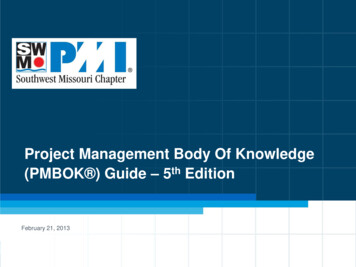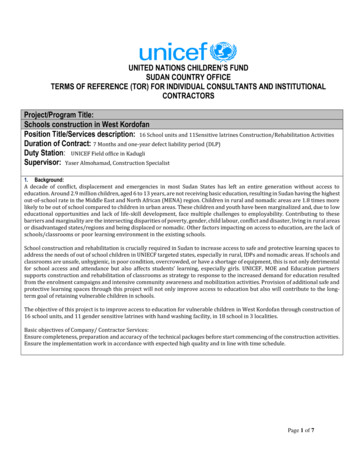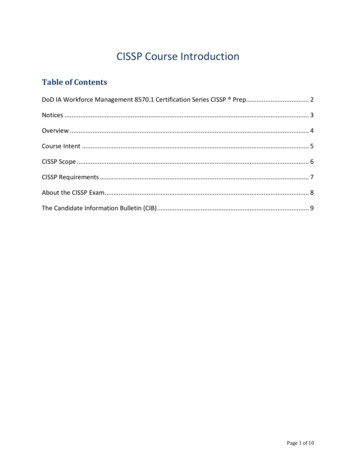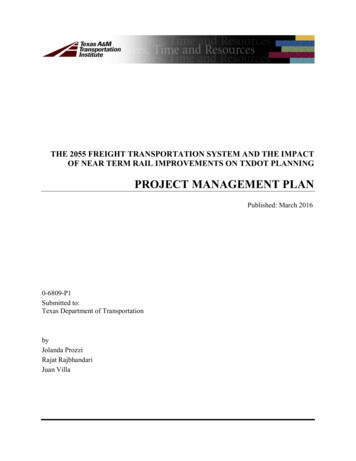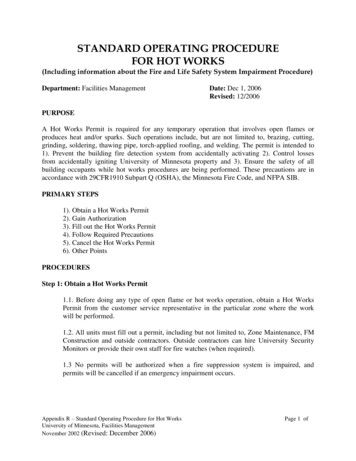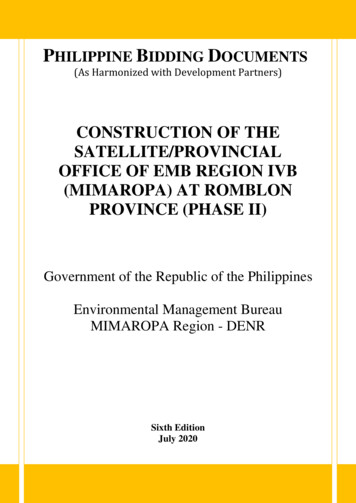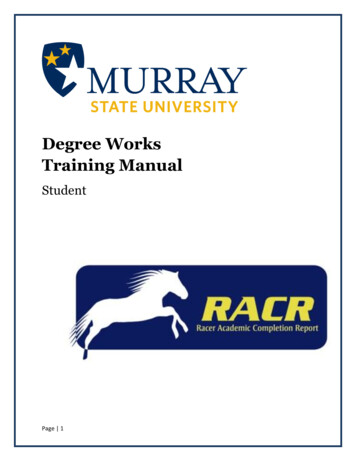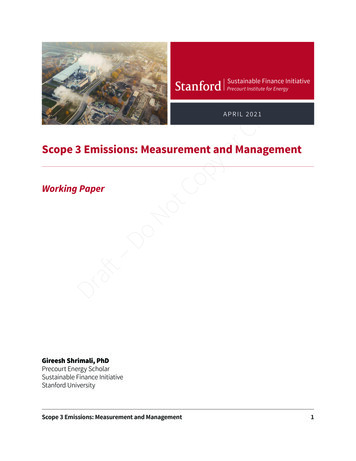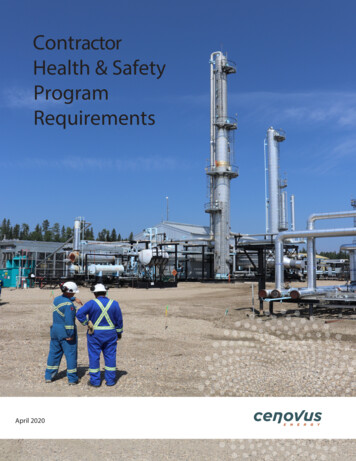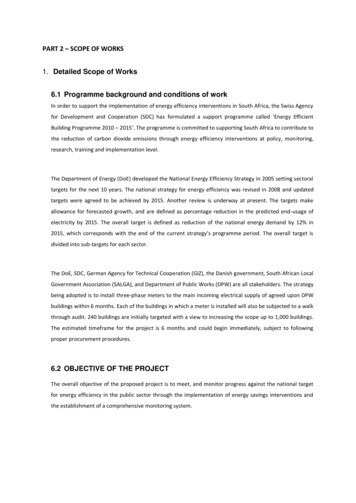
Transcription
PART 2 – SCOPE OF WORKS1. Detailed Scope of Works6.1 Programme background and conditions of workIn order to support the implementation of energy efficiency interventions in South Africa, the Swiss Agencyfor Development and Cooperation (SDC) has formulated a support programme called ‘Energy EfficientBuilding Programme 2010 – 2015’. The programme is committed to supporting South Africa to contribute tothe reduction of carbon dioxide emissions through energy efficiency interventions at policy, monitoring,research, training and implementation level.The Department of Energy (DoE) developed the National Energy Efficiency Strategy in 2005 setting sectoraltargets for the next 10 years. The national strategy for energy efficiency was revised in 2008 and updatedtargets were agreed to be achieved by 2015. Another review is underway at present. The targets makeallowance for forecasted growth, and are defined as percentage reduction in the predicted end-usage ofelectricity by 2015. The overall target is defined as reduction of the national energy demand by 12% in2015, which corresponds with the end of the current strategy’s programme period. The overall target isdivided into sub-targets for each sector.The DoE, SDC, German Agency for Technical Cooperation (GIZ), the Danish government, South African LocalGovernment Association (SALGA), and Department of Public Works (DPW) are all stakeholders. The strategybeing adopted is to install three-phase meters to the main incoming electrical supply of agreed upon DPWbuildings within 6 months. Each of the buildings in which a meter is installed will also be subjected to a walkthrough audit. 240 buildings are initially targeted with a view to increasing the scope up to 1,000 buildings.The estimated timeframe for the project is 6 months and could begin immediately, subject to followingproper procurement procedures.6.2 OBJECTIVE OF THE PROJECTThe overall objective of the proposed project is to meet, and monitor progress against the national targetfor energy efficiency in the public sector through the implementation of energy savings interventions andthe establishment of a comprehensive monitoring system.
6.3 Specific Objective of the ConsultancyTo obtain data relating to consumption patterns in public buildings, and to identify potential energy savingsinterventions within those buildings. Walk through energy audits will be undertaken and/or smart metersinstalled in up to 1,000 buildings, beginning with a sample of 240 buildings (the number of sample buildingsto be audited is subject to the discretion of the DoE). This will form part of the existing Energy EfficiencyMonitoring and Implementation Project (EEMIP) funded by the Swiss Agency for Development andCooperation (SDC). The data will also be used for Energy Performance Certification (EPC) in public sectorbuildings.6.4 Scope of Work6.4.1Installation of tele- or smart energy meters Provision and installation of one or several tele- or smart energy meters that allow reading ofenergy consumption from one central point outside the measured building.The meters shall comply with the following basic requirements:The system needs to measure, uninterrupted, various inputs on a high /low current (I), Voltage (V) anddemand Kilo Volt-Ampere (KVA) of buildings and report data back to a central database (Server). There shallbe a web based HMI that is easy to use and already established where such sites are being monitored.1. Communications1.1 Local: IEC 62056-211.2 Remote: Optional RS2321.3 Fast data collection using Data Stream Mode, and 90 days data in 30 seconds2System Connections/ Logging Hardware2.1 3 Element meters: 3 phase 4 wire3Security3.1 The meter has many security features. The meter stores all registration and configuration data to nonvolatile memory card installed inside4TECHNICAL DATA4.1 y: kWh Class 1 or Class 2 and kVarh Class 2 or Class 3Modular design to allow future upgradesComprehensive tariff structure, InstrumentationLarge digit (9.8mm) display, IEC 62056-21 communications portInternal clock with battery back-up and·15 year product lifeExtensive security data, double insulated and polycarbonate caseCompact design4.2 OptionsBID DOCUMENT EE 0104 VF5 – SDC ENERGY EFFICIENCY MONITORING - Public Buildings2
4.2.14.2.24.2.355.1.15.1.25.1.35.1.45.1.55.1.6 5.1.75.1.85.1.9kWh export, kVAh (Kilo-Volt-Amp-hours) and kVACurrent Transformer (CT) or direct connected, serial communications and load profilingCan be read without power by using replaceable batteryUSER INTERFACE & DATABASESoftware capabilities must include the following specifications namely:Software shall be username and password drivenSoftware shall be easy to use and shall display summarised customised data on firstMust be able to capture all details of the buildings that the unit is installed including5.1.4.1Region5.1.4.2Municipal Area5.1.4.3Address5.1.4.4GPS coordinatesGPS coordinates must be able to be referenced to another site i.e. another weather station’s dataAll data shall be able to be extracted in CSV format in all of the following intervals for any selectabledate and time.30 Min60 MinDayMonthDifferent methodologies shall be able to be used for different sites and any amount of customisedcalculations shall be allowed.An infinite number of charts shall be allowed and shall be user defined.Charts shall show values and must be able to be zoomed in, to see information clearly and moreprecisely5.2 Database5.2.1Data must be written to a central database (SQL server or equivalent) in a secure environment.5.2.2Data must be backed up at regular intervals and redundancy measures shall be in place.In addition to the supply and installation of the above meters, the contractor will be responsible for: Collection of historic data (annual consumption for the last three years) and establishment ofan energy consumption baseline. Historic data can be obtained directly from the utilityprovided the meter number is taken. Communication and approval (if needed) with ESKOM or relevant utility if meters are installedparallel to existing ones.It is acceptable if ESKOM or the local utility provides some or all meters as long as access by DoE to the dataproduced can be provided for.6.4.2 Smart Meter Data Storage & ReportingStorage Data on smart meters must be readable remotely – half hourly data must be transmittedusing GSM/ GPS to the database that will be hosted by SANEDI.NB: The contractor is responsible for ensuring that all meters are correctly installed, including relevantsoftware for data transmission, and that data is being transmitted without error to the SANEDI database*.BID DOCUMENT EE 0104 VF5 – SDC ENERGY EFFICIENCY MONITORING - Public Buildings3
The data is the property of the Department of Energy and the database shall therefore be handed over in itstotality on completion of contract. If the Department requests a copy of the data during the contractimplementation, this shall also be provided.* Service Providers shall be informed if the database server is located elsewhere.6.4.4Walk-through Energy AuditsThe walk through audit will include following steps: Interview with the management Collect data related to nature of the building, activity undertaken within the building and buildingfloor space. Obtain historic data on annual energy consumption, both from electricity and other sources Overview of the building with regards to any energy production units, processes and energyconsuming equipment Do a walk-through of the whole building, collect data and take pictures. Identify the energy production equipment and major consuming equipment. Check and recordkey data from marking plates. Pay attention to areas and equipment with high energy consumption. Look at habits and procedures that could be changed to improve energy efficiency. Identify of potential energy saving measures, both related to electrical installations andmachinery and other measures (such as insulation, natural lighting, etc).The aim of the Walk Through Audit is to list all potential energy saving measures found. The Walk-ThroughAudit usually takes up to 1-2 days, depending on the size and complexity of the building. The purpose is tomeet the management and staff, and get a general impression of the state of housekeeping, maintenance, andthe support from the staff for the further Auditing work.ReportingReports shall be made for each simple Walk Through Audit. Examples of the content of the Audit reports arepresented in Appendix one. The content of the Audit report will be described during the project inception.Besides general recommendations for potential pilot projects in the report, its main purpose is to prepare foridentification of specific energy efficiency interventions, more detailed analysis where necessary, and eventualintroduction of the Energy Performance Certificate programme.BID DOCUMENT EE 0104 VF5 – SDC ENERGY EFFICIENCY MONITORING - Public Buildings4
Content1. Executive summary2. Introduction2.1 Background and Objective2.2 Short presentation of the building2.3 Scope of works, description of the Auditmethodology and output.2.4 Involved persons in the Audit and amount of input2.5 Overall list of used Audit equipment and softwareExplanationKey data to be includedIn this section a short description is made about: Production and address of industry. Name of responsible persons (owners, operation The project purpose The premises where the Audit is performed The Audit work including presentation of theand maintenance staff) Auditors and involved staff from the company Audit measuring equipmentName and information of contact person at thebuilding during the Audit. Report outputPersons from the building, who have assisted withthe Audit. Names, positions and contact information of theinvolved Auditors3. Assumptions3.1 Electricity price3.2 Fuel price3.3 Water and wastewater prices3.4 Other assumptionsIn this section all the important assumptions arepresented including payment, price and tariff forelectricity and fuel. These are the basis for thecalculations of costs. Description of origin of data usedfor determining energy consumption (bills, metering, etc.)4. Production4.1 Building descriptionIn this section the building is described and shouldinclude but not limited to the following:2- A plan on the site of the property in m ;-Building information with plans on elevations,sections and all floors;-Nett floor area (excluding garages and storages asdefined by SANS 204 & 10400XA) of every single List of used Audit equipment and software Unit prices of the used energy Subscription rate/load fee (fixed part)
building, clearly separating nett floor area fromoutside area, storages and garages;-Vacant floor areas differentiated in A 30% vacantper year, B 60% vacant per year and C 0%vacancies/always occupied;-Classification of each single building according to theNational Building Regulation (office block G1.etc.);-Occupancy: If more than 10% of the building isoccupied by a different classified building (e.g. shopson ground floor), then the occupancy rate of everyclassification has to be specified; and-All energy using devices and types (that run on gas,electricityorrenewable)sothatenergyconsumption data can be displayed foroeach single building (excl. garages andstorage),obuilding parts that are not included in thenett floor area: balconies, terraces, garages,storages etc, andoBID DOCUMENT EE 0104 VF5 – SDC ENERGY EFFICIENCY MONITORING - Public Buildingsthe surrounding property (garages, garden6
illumination pools, etc.)5. Energy overall5.1 Energy sources, Fuel and Electricity supply anddistribution5.2 Overall consumption & costs5.3 Intensity of Energy5.4 Energy Utilisation per process5.5 Energy Management System Energy sources/supply Energy sources Presentation of the overall annual data for energy Overall annual energy consumption for the last 3usage for at least the last 3 years. Provision ofyearsconsumption data for the nett floor area of every The intensity of energy consumptionsingle building, i.e. energy consumption in garages, Installed main meters and sub metersstorages, pools etc have to be deducted if there isonly one meter for the entire property available! Ifenergy outside of the building cannot be measuredindividually, its consumption has to be estimatedbased on actual load, estimated running times etc. Energy pattern and profile yconsumption per square meter Description of the electrical system Descriptionofthemanagement system (if any), including meteringprocedure.6. Steam and heat production6.1 Description of boilers, kilns, oven, etc.6.2 Flow charts6.3 Fuel system6.4 Efficiency of boilers, kilns, oven6.5 Steam, Water and Condensate system6.6 Pipe installationBased on the questionnaire and information collected ofthe individual heat production systems aredescribed: Description of each boiler, kiln, oven, etc. Efficiency measurementsBID DOCUMENT EE 0104 VF5 – SDC ENERGY EFFICIENCY MONITORING - Public Buildings7Used Audit equipment
6.7 Operation and maintenance6.8 Proposal for improvements and problems experienced Operation and maintenance details Operation hours and use Fuel source and consumption Efficiency and heat losses7. Cooling system7.1 Description of system7.2 Flow chart7.3 Equipment operation and maintenance7.4 Efficient use of refrigeration7.5 Pipe installation7.6 Proposal for improvements and problems experiencedBased on the questionnaire and information collected ofthe cooling/chiller system is described:8. Compressed air system8.1 Description of system8.2 Flow chart8.3 Equipment maintenance8.4 Efficient use of compressed air8.5 Proposal for improvements and problems experiencedBased on the questionnaire and information collectedthe compressed air system is described including:9. Pumps and motors9.1 Description of pumps and motors9.2 Equipment operation and maintenance9.3 Proposal for improvements and problems experiencedBased on the questionnaire and information collectedpumps and motors are described including: Cooling system including a flow chart Electrical consumption and system performance Condition of the cooling Use of compressed air including flow chart Operation and maintenance details; operationUsed Audit equipmentUsed Audit equipmenthours and use Use of pumps and motors Effect factor of pumps and motors Operation and maintenance details; operationUsed Audit equipmenthours10. Electricity utilization10.1 Describe the distribution and consumption10.2 Electricity measurements, equipment and method10.3 Measurement results and analysis10.4 Proposal for improvements and problemsBased on the questionnaire and information collectedthe utilization of electricity is described including: Operation and maintenance details; operationBID DOCUMENT EE 0104 VF5 – SDC ENERGY EFFICIENCY MONITORING - Public Buildings8Used Audit equipment
experienced11. Other equipment using energy (e.g. industrial cookers)11.1 Description of equipment and energy consumption11.2 Collected data and analysis11.3 Proposal for improvements and problemsexperiencedhours and useThe types of other equipment are described: Used Audit equipmentType, size and capacity compressed air includingflow chart Operation and maintenance details; operationhours and use12. Energy saving measures12.1 Overview and Conclusion12.2 Recommendation for energy savings12.3 Savings, Investment and Payback periodThe conclusion of the Audit with proposals for energysaving measures. The energy savings are calculated,investment estimated and simple payback periods arepresented. Savings in energy units Potential savings in cost Estimated investment cost (low, medium and highcost)BID DOCUMENT EE 0104 VF5 – SDC ENERGY EFFICIENCY MONITORING - Public Buildings9
OutputThe contractor shall submit a Walk Through Energy Audit Report for each building.6.4.5Energy Audits QuestionnaireAn energy audit questionnaire must be provided as part of the methodology for carrying out theenergy audits.6.4.7Skill Transfer, Training and Jobs During the implementation of the project there will be identification of relevant personnel in theorganization occupying the building to ensure sustainability of the use of the meters. As part of the completion report the number of jobs created during the pilot will be indicated.6.4.8Work PlansThe duration of the project should not run beyond 6 months after commencement date. A time-schedule showingall scheduled project milestones and shall be based on the list of 240 priority buildings. See Annexure 2 and PricingSchedule.6.4.9Project AreasAll the priority sites for project building areas are listed according to categories in Annexure 2.6.5EXPECTED OUTPUTSThe progress and success of the program will be measured by the quantity and quality of the data gathered bymeans of completed questionnaires, the data retrieved from the smart metering server, and the energy auditreports. It should be noted that the quality of data is crucial as the Department of Energy and SANEDI will usethis data and information as part of the development of Energy Efficiency Target Monitoring System, and thedevelopment of Energy Performance Certificates for buildings.The energy consumption data collectedthrough the smart meters shall be analysed, and a report with clear energy saving potentials andimplementation recommendations will be drawn up for each building.The evaluation of the project will be done according to the following work stream descriptions: Data collection, capturing and analysis, including the energy audits questionnaires completed per buildingand installation of smart meters;BID DOCUMENT EE 0104 VF5 – SDC ENERGY EFFICIENCY MONITORING - Public Buildings10
6.5.1Data analysis; Identification of energy savings potential; and The output will be in the form of a final report for each building. The final reports and all raw data will bemade available to the Department of Energy and Department of Public Works in order for it to be utilisedfor the purposes of the initiatives mentioned above.Completion Report The completion report will be provided per building in line with the guidelines provided in Annexure 1 6.5.3For every building\facility data will be completed for the questionnaire provided.TIMEFRAMEThe duration of the project should not run beyond 6 months after commencement date. A time-scheduleshowing all scheduled project milestones must be included in the proposal.BID DOCUMENT EE 0104 VF5 – SDC ENERGY EFFICIENCY MONITORING - Public Buildings11
The data will also be used for Energy Performance Certification (EPC) in public sector buildings. 6.4 Scope of Work 6.4.1 Installation of tele- or smart energy meters Provision and installation of one or several tele- or smart energy meters that allow reading of energy consumption from one central point outside the measured building.
